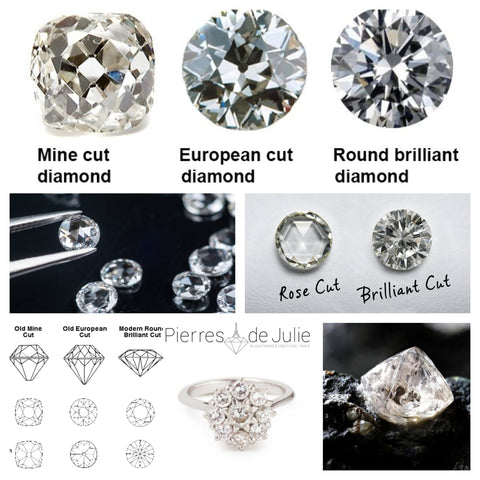Why does the diamond shine?
Very well known, diamond is the queen of the precious stones.

Being able to be of any color, the diamond also shines by its exceptional brightness and its rainbow lights. With a hardness of 10, the last step of the Mohs scale which is used as a reference to estimate the hardness of minerals, the diamond can only be scratched by itself. Surrounded by myths and legends, people have always tried to unravel the mystery of its incredible brilliance. So why does a diamond shine? Here are some elements to better understand the origins of the brilliance of the most famous gem.
What is the brillant cut for a diamond?
Brilliant cut refers to a way of cutting a diamond that contributes to its appearance and light reflection qualities. The brilliant cut is actually the most well known and widely used round cut. This cut has even become the symbol of the perfect diamond. It is indeed the one whose proportions are the most harmonious, close to perfection for all gem specialists, from the diamond dealer to the jeweler to the enlightened amateur.
The quality of the diamond cut, i.e. the respect of the ideal proportions, the quality of the symmetry of the facets as well as the fineness of the polishing is part of the 4 C criteria. It ensures that the light that enters the diamond can come out through the table. This is what gives the diamond the brilliance that we know today.

What are the different cut for a diamond?
Of course, as can be seen on many rings, necklaces, earrings, etc., diamonds can be cut in many other types of cuts such as pear, heart, marquise, princess…

What is the difference between a diamond and a brillant?
A brilliant is a diamond while a diamond is not necessarily a brilliant. Do you understand the difference? All brilliants are diamonds because the term “brilliant” refers to the way the gemstone is cut. On the other hand, as we have just discussed, diamonds can be cut in a variety of ways, each of which enhances one aspect of this wonderful gem.
What is the price of a brillant?
The price of a diamond varies according to different criteria:
– The weight ;
– The date;
– The shape of the cut;
– The purity;
– The graduation of the color.
It is therefore impossible to give a generic price, because it does not exist. The price of a diamond can be evaluated after examining each of the criteria.

History of the brillant cut
One might think that the brilliant cut diamond we know today has always existed. But that’s not the case, because this cut was born with the scientific and technological advances that have allowed it to sublimate the diamond as well.
Diamonds historically come from India with the famous Golconde mine as well as from the island of Borneo known for its colored diamonds. These civilizations were the first to think about the faceting of these stones found in secondary deposits resulting from the erosion of primary deposits. These stones, with their generally frosted and corroded surface, will have to regain their brilliance through a table setting or polishing of the largest surface and then, at best, facets will be added.
In Europe, during the Middle Ages, gem cutters’ guilds were organized. They were officially recognized in Paris in 1290, at which time the faceting of diamonds became more complex and a desire to make the facets symmetrical to each other was noted.
In the 18th century, the Mazarin cut developed. Indeed, the cardinal and minister of Louis XIII, a great lover of art and gems, financed the development of a diamond cut. Once cut, the stone will form a rounded cushion with 34 facets.
Also in the seventeenth century in Italy, in Venice, Vincenzo Peruzzi develops the size of the diamond by adding facets on the crown and on the breech of the stone. The diamond has 58 facets, we are then very close to the 57 facets of the modern brilliant cut.
In the 20th century, with the evolution of knowledge in optics and crystallography, Marcel Tolkowski defined the modern brilliant cut in 1919. This diamond has 32 facets between the table and the rondiste and 24 facets between the rondiste and the culet. We then have the famous 57 facets of the modern brilliant cut.
Marcel Tolkowski sets the proportions of the modern brilliant cut recognized in North America.

In 1966, other standards slightly different from the standards of Tolkowski will appear: the Scandinavian standards of Tillander. This nomenclature serves as the basis for the modern brilliant cut with proportions table/crown/facet slightly different from the standards set by Tolkowski.
In 1978, the International Diamond Concil (IDC) defined the standards that give the diamond the most refraction. These standards are a combination of the professional experience of diamond dealers and the knowledge of scientists in the field of optics.

If you are interested in diamonds, don’t hesitate to discover what Les Pierres de Julie offer in our store…
We are also available for any free expertise of your diamond jewelry, for that you can send an email with your photos to contact@lespierresdejulie.com.
Whether you're interested in buying a piece of jewellery or a stone, a free jewelry appraisal or jewelry resale, Pierres de Julie welcomes you to its Parisian boutique in the Village Suisse, a stone's throw from the Ecole Militaire and the Esplanade des Invalides.
Nouveautés
- 18.000 €
- 18.000 €
- Unit price
- / per
- 1.800 €
- 1.800 €
- Unit price
- / per
- 1.950 €
- 1.950 €
- Unit price
- / per
- 5.950 €
- 5.950 €
- Unit price
- / per











